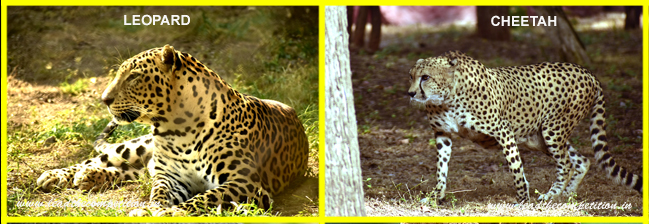Differences between Similar Animals
Leopard and Cheetah
| Leopard (Panthera pardus) | Cheetah (Acinonyx jubatus) |
|---|---|
| Large and muscular | Tall and slender |
| Larger head | Head is small in relation to its body |
| Rosette shaped spots covering whole body and face | Single large spots like thumb prints. |
| It has white eye-linings at the bottom of the eyes | It has tear lines which run from the eyes down to the sides of the mouth |
| All the claws are fully retractable | Except the dew claw, none of its claws are retractable |
| In addition, Cheetah's tail is flat towards its end to help it while running, its nostrils are large in size to allow maximum oxygen in-take for their muscles, while running at high speeds. The non-retractable claws give the Cheetah a firm grip on the ground. | |

African and Asian elephant
| African elephant (Loxodonta africana) | Asian elephant (Elephas maximus) |
|---|---|
| Weight :4000 - 7000 kg | Weight: 3000 - 6000 kg |
| Highest point: Shoulder | Highest point: Back |
| Bigger ears reach upto the neck | Smaller ears |
| Both sexes have tusks with males having bigger | Females have rudimentary or no tusks |
African and Asiatic Lion
| African Lion (Panthera leo) | Asiatic Lion (Panthera leo persica) |
|---|---|
| Weight :330 - 500 pounds | Weight: 350 - 420 pounds |
| Mane: Thicker mane | Mane: lesser than African lion, hence ears are visible always |
| Tail: shorter than Asiatic lion | Tail: longer tail with longer tail tuft |
| Almost all African lions lack the longitudinal fold of skin that runs along the belly of Asiatic lions. | The most distinguishing feature of Asiatic lion is the longitudinal fold of skin that runs along the belly |
| Habitat: Sub-saharan Africa | Gir forest of Gujarat |
Crocodile and Alligator
| Crocodile | Alligator |
|---|---|
| Long, narrow V shaped snouts | Wide U-shaped snouts |
| Upper and Lower jaws are of same width | Upper jaw is wider than lower jaw |
| Teeth of both the jaws are exposed in interlocking pattern | Teeth of only upper jaw are exposed |
| Crocodile is nearly olive brown in colour | Alligator is almost black in colour |
| Both crocodiles and alligators found around the world. The gharial, which has a much narrower snout than other species in this order is found only in India. | |
Raven and Crow
| Raven | Crow |
|---|---|
| Raven is larger about the size of a hawk | Smaller about the size of a pigeon |
| Wedge-shaped tail | Fan-shaped tail |
| Call is hoarse and croaking | Call is nasal and high pitched |
| Prefers wild areas for habitat | Lives closer to human habitats |
Tortoise and Turtle
| Tortoise | Turtle |
|---|---|
| Dwells mostly on land | Dwells mostly in water |
| Has dome shaped shells | Has flat, streamlined shells |
| Short feet with bent legs | Webbed feet with long claws |
| Lifespan is upto 150 years | Lifespan is upto 40 years |
Ape and Monkey
| Ape | Monkey |
|---|---|
| Lives at least sometimes on ground | Lives almost entirely on trees |
| Does not have tail | Has tail |
| Brain size is large | Brain size is small |
| Upright posture, humans are entirely bipedal | Quadrupedal (walk on four limbs) |
| Can live upto 60 years | Can live upto 30 years |
| Only around 23 species known | Hundreds of species known |
| Examples: Gibbon, Gorilla, Orangutan, Chimpanzee, Bonobo, Humans | Examples: Monkey, Langur, Mandrill, Macaque, Baboon, Marmoset, Tamarin etc. |
Doves and Pigeons
Both doves and pigeons belong to the same family of birds called Columbidae.
The difference between doves and pigeons lies in their size.
- Doves are smaller and some weigh as less as 22 grams while pigeons are large birds may weight upto 4 kg.
- Doves have pointed tails while pigeons have rounded tails.
Eagle and Hawk
Eagles are larger in size when compared to hawks, they have longer wingspan and also are more powerful.